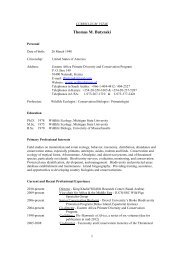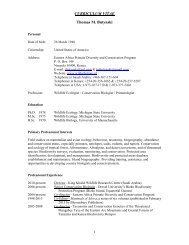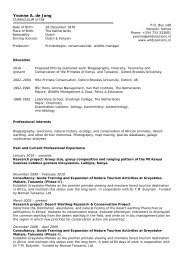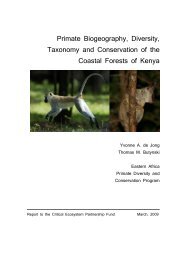Zanzibar red colobus on Pemba Island, Tanzania - Wild Solutions
Zanzibar red colobus on Pemba Island, Tanzania - Wild Solutions
Zanzibar red colobus on Pemba Island, Tanzania - Wild Solutions
Create successful ePaper yourself
Turn your PDF publications into a flip-book with our unique Google optimized e-Paper software.
Mammals<br />
and the largest group comprised <strong>on</strong>ly six animals. Although the 2000 census<br />
located <strong>on</strong>ly <strong>on</strong>e group of (at least three) P. kirkii, interviews with local people<br />
suggested that two other groups (of 5 - 8 and 5 - 7 animals) occur<str<strong>on</strong>g>red</str<strong>on</strong>g> in Ngezi<br />
Forest. A fourth group of 4 - 6 animals was said to be present in an aband<strong>on</strong>ed<br />
clove plantati<strong>on</strong> c. 6 km south of Ngezi Forest. The c<strong>on</strong>clusi<strong>on</strong> of the 2000 census<br />
is that there were 15 - 30 P. kirkii in Ngezi Forest.<br />
During the 2011 census (5 days; 53 hrs of census by two primatologists) we<br />
located two groups (of at least 7 and 8 animals) and found str<strong>on</strong>g evidence<br />
(leaves from which the petiole had been bitten-off) for three additi<strong>on</strong>al groups. We<br />
c<strong>on</strong>clude that there are likely no fewer than 35 P. kirkii in Ngezi Forest, with the<br />
actual number perhaps closer to 40. There were no reports of P. kirkii at any other<br />
sites <strong>on</strong> <strong>Pemba</strong>. Thus, 38 years after the introducti<strong>on</strong> to <strong>Pemba</strong>, the populati<strong>on</strong><br />
has more than doubled, but c<strong>on</strong>tinues to be small. The five groups were widely<br />
scatte<str<strong>on</strong>g>red</str<strong>on</strong>g> across Ngezi Forest with the shortest distance between groups being<br />
700 m and the farthest distance being 6 km. Groups appear to have an affinity for<br />
forest edge next to, or over, water (e.g., forest-mangrove ecot<strong>on</strong>e, swamp forest).<br />
Major difficulties faced<br />
Insufficient informati<strong>on</strong>: The absence of any m<strong>on</strong>itoring during the first 17<br />
years (1973 - 1990) post-release, and of a low level of m<strong>on</strong>itoring over the<br />
past 21 years (1990 - 2011), greatly limits what can be learned from this<br />
introducti<strong>on</strong>. For example, we do not know the rates of growth or decline of<br />
this populati<strong>on</strong>, nor the problems that this populati<strong>on</strong> encounte<str<strong>on</strong>g>red</str<strong>on</strong>g>. A detailed<br />
census needs to be c<strong>on</strong>ducted of this populati<strong>on</strong> so that its size, age/sex<br />
compositi<strong>on</strong>, and distributi<strong>on</strong> are better understood. Detailed censuses should<br />
then be repeated at least <strong>on</strong>ce every 5 years. Intensive ecological studies<br />
should be undertaken <strong>on</strong> this populati<strong>on</strong> with the objectives of better<br />
understanding what impact P. kirkii is having <strong>on</strong> the ecosystem and what<br />
factors are most limiting populati<strong>on</strong> growth. Genetics research (using fecal<br />
samples) needs to be c<strong>on</strong>ducted in order to assess the level of inbreeding and<br />
the need for translocating new animals into this populati<strong>on</strong> (see next bullet<br />
point). The genetic diversity of this populati<strong>on</strong> should be regularly m<strong>on</strong>ito<str<strong>on</strong>g>red</str<strong>on</strong>g> in<br />
order to assess the need for translocati<strong>on</strong>s.<br />
Probable inbreeding depressi<strong>on</strong>: Given the size of Ngezi Forest, and the high<br />
diversity of plant species, it seems unlikely that food is limiting this populati<strong>on</strong>.<br />
At present, P. kirkii probably occupy less than 10% of that part of Ngezi Forest<br />
that is cove<str<strong>on</strong>g>red</str<strong>on</strong>g> by moist forest (c. 10 km²). Now, 38 years (about four<br />
generati<strong>on</strong>s) post-release, this populati<strong>on</strong> (which is based <strong>on</strong> <strong>on</strong>ly 15<br />
founders), may be suffering from inbreeding depressi<strong>on</strong>. If the present<br />
objective is to maintain the l<strong>on</strong>g-term viability of this isolated populati<strong>on</strong>, then<br />
at least <strong>on</strong>e supplemental release of P. kirkii from <str<strong>on</strong>g>Zanzibar</str<strong>on</strong>g> is warranted as<br />
this should help to over-come what may be a genetic bottleneck. Individuals <strong>on</strong><br />
<str<strong>on</strong>g>Zanzibar</str<strong>on</strong>g> that are likely to perish due to habitat loss are the most suitable<br />
candidates. The number to translocate, and the time frame, need to be<br />
determined, but even a small number might c<strong>on</strong>tribute significantly towards out<br />
-breeding the Ngezi Forest populati<strong>on</strong>.<br />
171






